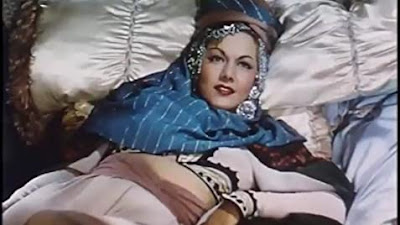THE QUEEN OF TECHNICOLOR: MARIA MONTEZ IN HOLLYWOOD. Tom Zimmerman. University Press of Kentucky; 2022. NOTE: This review based on uncorrected galleys.
Born in the Dominican Republic to a well-heeled family, Maria Montez married a much-older man whom she up and left flat after seven years to pursue her dreams of a career as an actress -- this despite having no discernable talent. Montez lived off a wealthy man's yacht for months, then during her stay in Manhattan managed to secure Bob Hope's agent "Doc" Schnurr. based solely on her looks. She was attractive but had to be carefully photographed, as her features could come off as heavy and unflattering. In general she looks much better in her technicolor movies than she does in still photographs.
Montez made up so many stories about herself that no one believed her when she claimed to be engaged to a fighter pilot in the British air force -- people assumed he was a fictional entity -- but the man actually existed and did have a relationship with Montez, although they may or may not have been engaged.
One critic wrote that Montez had "the regality of an
usherette." Once she began actually starring in movies (for a big but still second-string studio, Universal) Montez wanted to be "taken seriously." Her chief attribute when it came to thesping was radiating a haughty superiority, but she was no Hepburn. Refusing to appear in a western that she thought was too similar to her other films, Montez went on suspension even as Yvonne De Carlo replaced her and was groomed, in fact, to be her replacement at the studio. Universal eventually offered her a bone, the lead role in Tangier, but the picture was considered a stinker and those certain qualities that Montez exhibited in her earlier films were missing -- as Zimmerman puts it, she was merely "ordinary." She parted company with Universal and moved to France with her new husband Jean-Pierre Aumont and the two appeared in the terrible Siren of Atlantis. Zimmerman suggests that Montez showed some genuine acting ability in her later independent films, but she was still trading in on her trademark haughtiness. Montez died in her bathtub at age 39.
 |
| Maria |
Verdict: For obsessive Maria Montez fans primarily, but also an interesting slice of Hollywood life. ***.

No comments:
Post a Comment